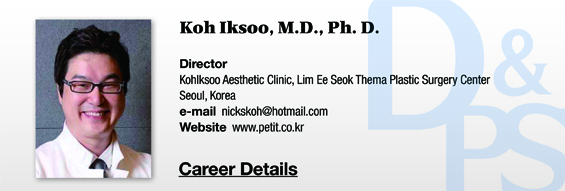Use a hard filler and place one block of the filler upon the periosteum and perichondrium. Injecting close to the skin surface could cause a complication such as nasal tip infection. It is more common to inject the filler immediately under the skin surface as this creates a markedly augmented appearance. However, the pressure dissipates on the nose bridge whereas, the nasal tip is very hard and retains pressure. Injecting the filler close to the skin surface will bring the pressure to the nasal tip. Necrosis is inevitable if a large amount is forcefully injected into a thin area. This can also cause the filler to seep into blood vessels and lead to vision loss. For these reasons, one should do their homework before venturing into minimally invasive rhinoplasty using dermal filler.
chin
The key to chin correction is to create a height in the center and soft wings that stretch to both sides. It is important to study the angles of a beautiful profile of the face. I believe the mouth can appear to be protruding in relation to the highest points of the nose and chin. I try to raise the height of the central chin in relation to the protrusion of the nasal tip to make the mouth appear less protruding. Such understanding is crucial in mouth protrusion correction as it uses the relationship between the nose and chin. Inject a hard filler above the periosteum in this area as well.
[Advertisement] FCR® (Fractional Prickle CoralCalcium Regentron) – Manufacturer: (www.illglobal.com)]
Lips
One should have a thorough understanding of the aesthetic standards of lips. The biggest problem with this area is that too often the focus is given to simply augmenting the volume. However, at close observation, lips have fine contours. It is important to maintain the contours of the upper and lower lips, without creating an inflated appearance. Lips that look like thick tubes are not attractive. A common mistake is injecting the filler on the surface. At a closer look, the lip has a clear boundary between the wet area and dry area. I recommend injecting the filler into the wet area as if to push the patient’s own tissues outward. Leave a little gap in the center of the lips and make sure to maintain the original outline of the lower and upper lips so they would have a natural fit. This is very difficult to do and requires a lot of practice. Most manufacturers recommend a filler of medium hardness for lips but I personally prefer soft fillers.
People may generally think that it is easy to create shapes with dermal filler but it is quite complicated in reality and becomes more difficult, the more you know. The goal is to provide volume, new shape and maintain the outcome for at least a year. Success does not come easy in this procedure and much research and training are needed to gain the necessary skills.
-To be continued





















